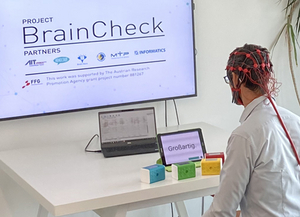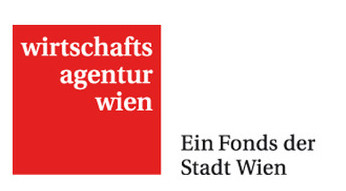Research Projects

Braincheck - new approach to early diagnosis of dementia with Artificial Intelligence
Dementia is a widespread neurodegenerative disease. In Austria, 10 percent of the population over 65 years suffer from it, but younger people are not spared from this disease either. The effects range from memory loss to the complete loss of all mental abilities. This is a serious burden, not only for the patients, but also for the social environment and especially for the family. Current diagnostic methods for dementia are expensive, complex and protracted. Usually tests are only carried out in cases of serious suspicion, by which time the damage is usually already advanced. Today, dementia cannot be cured, but the course of the disease can be slowed down, so early detection is extremely important.
The BrainCheck project, coordinated by AIT, addresses precisely this issue and develops a simple and inexpensive early diagnosis, suitable for large-scale screening, e.g. for preventive examinations from a certain age. If dementia is detected early, therapy can be started early and the course of the disease is significantly delayed. This form of diagnosis will also be helpful in the development of drugs against dementia, allowing the right test groups to be found and the process to be accelerated.
With BrainCheck, the brain waves, i.e. the EEG, are evaluated with the help of Artificial Intelligence, while the affected persons perform cognitive tasks. This is where the experts at the Competence Unit Digital Health Information Systems, Center for Health & Bioresources, can contribute years of experience in the field of automatic evaluation of brain waves. With encevis, a medical device has already been developed that supports international medical personnel in the diagnosis and therapy of epilepsy through automated EEG analysis.
"Road to digital Austria" contribution: https://www.atv.at/road-to-digital-austria/staffel-2-folge-28/d3149135/

POPAI - Personalized OPtimization of sports training with Artificial Intelligence methods
State-of-the-art sports monitors only measure the most general and global attributes: age, height, weight,heartbeat, and distance. POPAI will be a unique intelligent coaching system for optimizing the training of professional and recreational athletes. POPAI will not only be personalized as in knowing about your general physical attributes but will also have the intelligence to be personalized on a local muscle level. Lab-based V02-max measurements, invasivelactate analyses, and SpO2 monitoring will become irrelevant because we will measure these parameters non-invasively during sports activity directly within the muscles. The AIT will develop smart algorithms using deep-learning techniques for the analysis of oxygenation data combined with further modality.

DeepBrainResonater – Gaining insight in the brain function by using Deep Learning techniques
DeepBrainResonater will fundamentally change how EEGs are interpreted in the clinic: We will realize a deeplearning (Artificial Intelligence) based virtual assistant for interpretation of clinical EEG recordings , thus automating the current visual assessment by the clinical expert, reducing the burden of labor for the clinician and improving the interpretation quality. The DeepBrainResonater will be integrated into major EEG vendor systems and made available as an online service.

EEG4Stroke
Motivation: Stroke is one of the most frequent causes of long-term disability and death in developed countries. In Europe, the annual incidence of stroke will increase from 1.1 million in 2000 to 1.5 million in 2025. Accurate diagnosis and triage by paramedics is therefore pivotal to treat these patients faster and improve the outcome for stroke patients. Positive experience with EEG measurements in the ambulance ensures rapid decision making that may significantly reduce door-to-needle times.
Goal:The goal of EEG4STROKE is to develop a new product (integrated hard- and software) that enables paramedics to accurately triage patients with suspected stroke on-site (in the ambulance or living room of the patient). Early triage enables earlier hospital selection and faster treatment, which will drastically improve the patient’s chance of recovery.

Seizure AI - AI assisted diagnostic SEIZURE assessment from admission to report
Our goal is to help doctors diagnose seizure patients at expert levels while reducing cost and time spent. We will attain this goal by developing an AI covering seizure diagnostics from end to end capitalizing on the first chatbot assessing each patient’s case scoring their need for EEG monitoring, break-through EEG hardware enabling 72h home monitoring, automatic detection of personal EEG features, and an AI creating standardized reports including diagnostic interpretation.

CardioDSS - Cardio Diagnostic Decision Support System
Motivation: In inconclusive diagnostic cases patients have to be monitored at home using mobile ECG devices. A huge amount of data is being produced resulting in heavy workloads for doctors and in misdiagnoses, as actual events have to be manually detected amidst normal patterns artifacts. Patients have to wait for weeks for results while rates of misdiagnosis are still high. Meanwhile, doctors are uncertain of liability for life-threatening events in their unread mailbox requiring immediate action.
Goal: Our objective is to help doctors deliver better diagnosis while reducing time spent. We will achieve this by developing a new cardio diagnostic decision support service that capitalizes on advancements, including personalised ECG for more precise event detection, improved ECG signal quality and hardware usability, and automatic interpretation of ECG signs within the respective clinical context regarding further signs, symptoms, age, sex, and geography.

NeuroGuard XS: Multimodal Brain Monitoring System for Neonatal Intensive Care
Motivation: Neonates frequently suffer from neurological disorders and epileptic seizures causing serious brain injuries, lifelong disabilities or even childhood death. Today, brain monitoring of neonates in intensive care units is based on manual EEG data interpretation. Recent medical studies and feedback from clinicians recommend the addition of NIRS as a complementary modality to improve monitoring quality for (contra-) indication in a combined EEG/NIRS monitoring device, and to automate monitoring.
Goal: The NeuroGuard system will be a novel neuromonitoring device for neonates in intensive care units that for the first time combines electroencephalography (EEG) and near-infrared spectroscopy (NIRS). Multimodal data integration for joint signal analysis will support monitoring and allow to reinforce or contraindicate single-modality based medical diagnosis. This enables more targeted interventions and will allow more newborns to live a life without physical or mental impairments.

ICT4Epilepsy
About 56 million individuals on this earth don’t know, when the next seizure is going to hit them –while driving a car, climbing, during work, or even swimming. Antiepileptic drugs could help, but lim-ited oversight of which drug works for which patient prevents patients ultimately gaining access to their right treatment. In this project, we will develop ICTbased methodssupporting personalized se-lection of optimal epilepsy treatment and objectively monitoring treatment effects in the home envi-ronment.In addition, to monitoring classical AED therapy, this system will assist the evaluationof a new treatment option for epilepsy based on nanotechnology.
NeuroAssist - decision support system for assisting treatment and diagnosis of neurological disorders
In this project we will develop NeuroAssist - a decision support system for assisting treatment and diagnosis of neurological disorders - and integrate it tightly into current hospital information systems. Based on SYMPTOMA’s search engine, information from many different sources of medical data will be combined and physicians will be reminded of rare disease while getting an overview of what is most common for a patient with the respective set of findings. The decision support system will get its input form newly developed tools for automatic computer assisted EEG analyses and a new automatic semantic analysis of written neurological reports for the extraction of clinical findings. To make the system usable for as many hospitals as possible we will define a new standardized DICOM waveform format for EEG storage and propose it to the standardization committee. In addition, NeuroAssist will support medical research and will make the information of different sources accessible to the research community.
NeuroOnline - EEG web-based service
In this project we will develop a web-based service which will include tools for computerassisted analysis of long-term electroencephalographic (EEG) data for the diagnosis of neurological disorders as well as for polysomnographic (PSG) data for the diagnosis of sleep disorders. Based on the existing background on deep-learning in the consortium we will develop algorithms and web-based visualization tools for sleep staging, sleep apnea detection, and ICU-EEG-monitoring. Furthermore our developments will result in a technology for data streaming, - archiving, and exchange across departments. The integration of the computational results into the electronic health record and the conversation of proprietary data formats in standard formats (DICOM) are further important goals. This project will pave the way for national health services such as ELGA (AUT) and EFA (GER) to include EEG/PSG data in the document exchange infrastructures.
EpiMon - Monitoring EEG in the intensive care
According to current studies, up to 18% of all patients with severe brain diseases at intensive care units suffer from unrecognized non-convulsive epileptic seizures or status epileptici, which lead to significantly increased mortality or permanent neurological impairments. They are clinically incomprehensible and can be recognized reliably exclusively when long-term recording with EEG (cEEG) are performed. However, in clinical practice cEEGs are only available in exceptional cases. The reason for this is above all the time-consuming visual analysis of the very large amounts of EEG signals, which also requires the expertise of a physician experienced in EEG analysis. The lack of EEG monitoring of these patients thus represents a clinically relevant, largely unsolved problem. A computer-assisted, continuous automatic evaluation of the EEG signals can provide a significant contribution here and thus enable automatic alerting in case of an epileptic attack. Based on the highly reliable algorithms for the detection of epileptic seizures in patients undergoing pre-surgical evaluation, the problem of seizure detection in patients with severe brain diseases is now to be solved. In the project new mathematical methods for the detection of non-convulsive epileptic seizures in EEG signals of these patients were developed as well as correlations between the EEG signal and other physiological parameters such as heart rate, blood pressure, pO2 or brain pressure were be investigated.

DeNeCoR - Devices for NeuroControl and NeuroRehabilitation
The project addresses the diagnosis and treatment of neurological diseases which will have an increased incidence due to the aging society. DeNeCoR will develop, test and demonstrate neuro devices, systems and methods for a diverse set of diagnostic and treatment modalities.
Start: June 1st, 2013

ZIT - EEG monitoring for Stroke
Within the scope of the project, a system consisting of hardware and software is being developed, which is to be used for the rapid analysis of long-term EEG recordings in stroke patients. For the first time, our results will enable continuous EEG monitoring of brain function in stroke patients with reasonable resources and improve the quality of the diagnosis in this field of application.

HIGH-throughput production of functional 3D images of the brain
HIGH PROFILE aims to “establish an overall system approach for healthcare, based on an integrated system concept of seamless integration of interoperable components”. HIGH PROFILE addresses this explicitly in the field of Advanced Imaging Systems. The project will elevate the state-of-the-art by integrating imaging equipment for neurological diagnostics to support improved diagnosis.

Central Nervous System Imaging - advances of 3D imaging techniques (EEG, fMRI, PET)
This three-year ENIAC (European Nanoelectronics Initiative Advisory Council) project aims to achieve substantial advances in state-of-the-art medical 3D-imaging platforms by focusing on the diagnosis and therapy of serious diseases of the central nervous system and brain. Key medical-imaging technologies will be significantly enhanced by means of major improvements in sensors, equipment and computing platforms to boost early diagnostics and prevention capability while reducing total equipment costs.

ZIT - Spike detection
Within the framework of the proposed project, a new method is to be developed to recognize spikes in EEG data from epilepsy patients. Epilepsy is one of the most common neurological disorders. About one per cent of the world's population suffers from this disease, with about 80,000 people in Austria alone. Spikes are characteristic patterns in the brain signal of an epileptic. A new method is to be developed, which automatically determines the spike frequency and the morphology of the spikes from the brain signals.